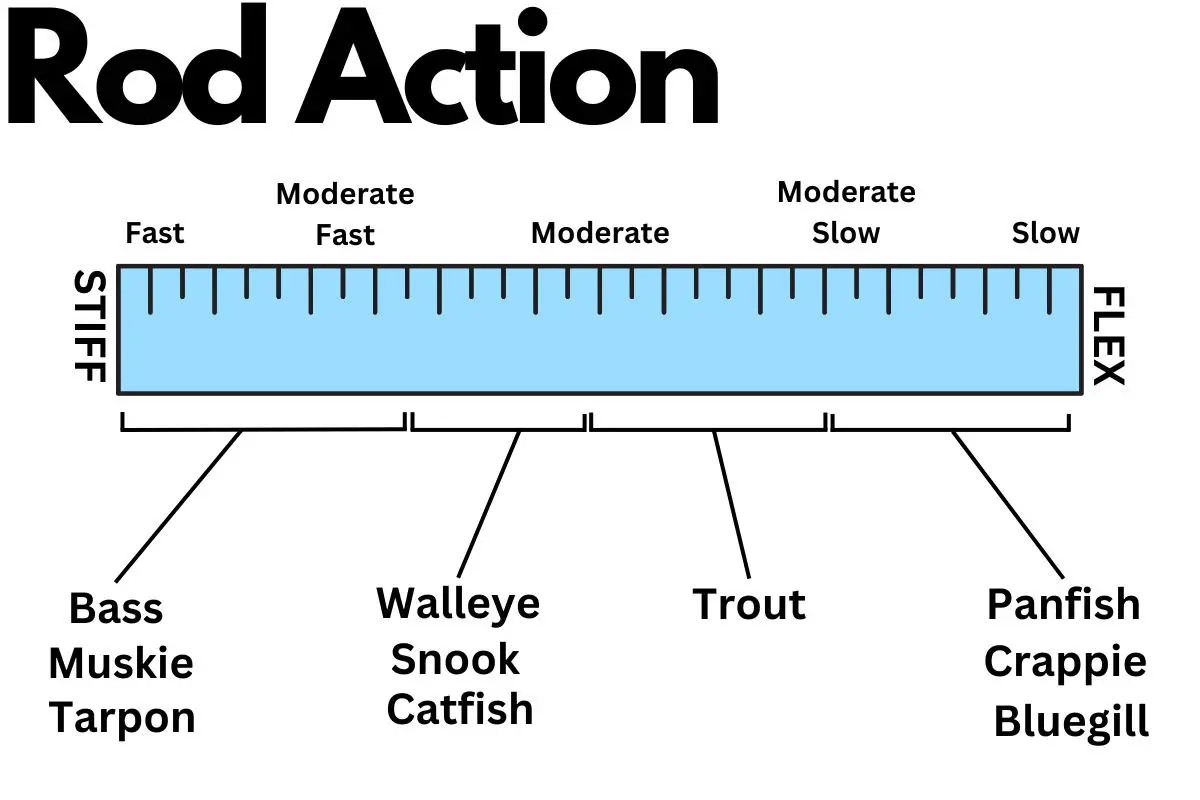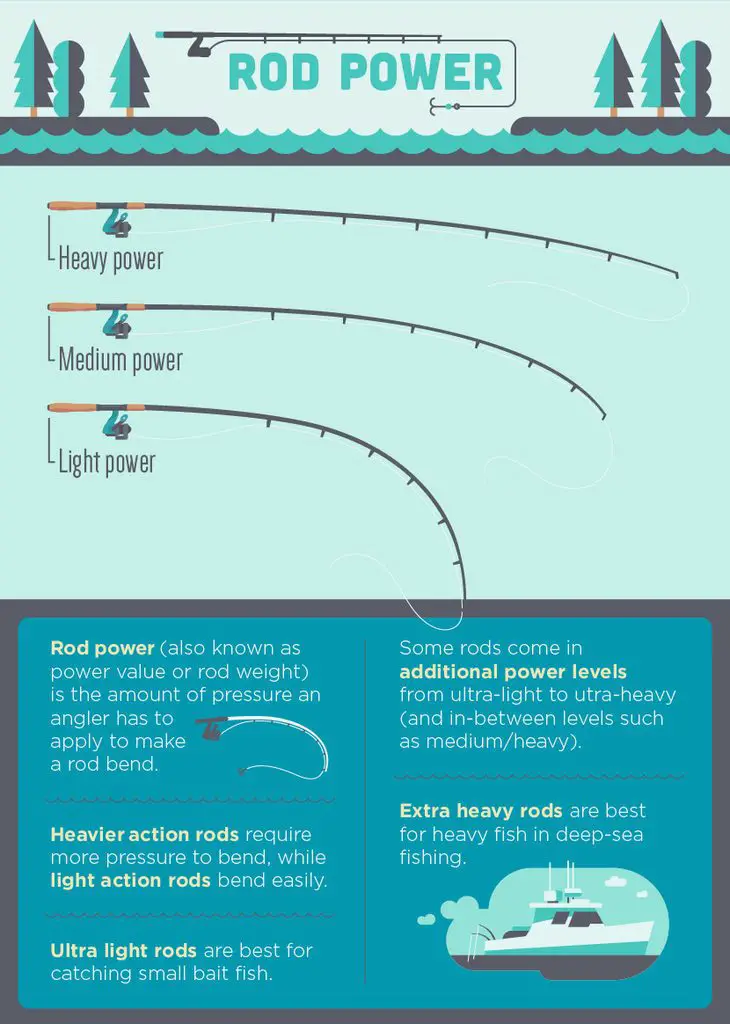Fishing rod action refers to the speed and point at which a rod bends under pressure. It’s categorized into three main types: fast, medium, and slow action. Fast action rods bend near the tip, medium action rods bend in the middle, and slow action rods bend throughout the entire length.
| Fishing Rod Action | Description | When Suitable |
|---|---|---|
| Extra Fast | Bends minimally near the tip, offering maximum stiffness and sensitivity | Ideal for heavy lures, targeting larger fish, and fishing in heavy cover or strong currents |
| Fast | Bends mostly in the top third of the rod, providing a blend of power and sensitivity | Versatile, suitable for various techniques and species, works well with jigs, worms, and spinnerbaits |
| Moderate-Fast | Bends in the top half of the rod, balancing power and flexibility | Suitable for crankbaits, swimbaits, and topwater lures; helps with casting distance and accuracy |
| Moderate | Bends evenly throughout the rod, providing a balance between power and flexibility | Good for treble hook lures, like crankbaits and jerkbaits, and for a smoother fight with the fish |
| Moderate-Slow | Bends mostly in the lower half, offering more flexibility than power | Good for treble hook lures, like crankbaits and jerkbaits, and a smoother fight with the fish |
| Slow | Bends throughout the entire rod, with maximum flexibility and limited power | Best for ultra-light lures and small fish; provides a cushion for light lines and delicate hooks |

Table of Contents
Extra Fast
An extra-fast action fishing rod is designed to have a very fast, responsive action. An extra-fast action rod is stiffer and more sensitive, with most bending happening near the rod tip.
Extra-fast action rods are used for techniques requiring quick, precise casts and high sensitivity to detect subtle bites. They are typically used for:
- Fishing with jigs, soft plastic lures, and jerkbaits, as they allow for better control and sensitivity in detecting bites.
- Casting lightweight lures or baits with precision, as the quick action provides better accuracy and distance.
- Fishing in heavy cover or structure requires strong hooksets and fast action to prevent fish from escaping or breaking the line.
An extra-fast action rod transmits vibrations from the line to the angler’s hand quickly and efficiently, enabling the angler to detect even the slightest bites.
I would pick an extra-fast action rod when fishing in situations that demand high sensitivity, quick hooksets, and accurate casting, especially with lighter lures. Some species that can be effectively targeted with an extra-fast action rod include bass, walleye, and some trout species.
Extra-fast action rods are best suited for lures like jigs, soft plastics, jerkbaits, and lightweight crankbaits. These lures require precise control, fast action, and strong hooksets, which an extra-fast action rod can provide.
However, they are not ideal for heavy, hard-pulling lures like large swimbaits or deep-diving crankbaits, as these require slower-action rods to maintain control and prevent the hooks from tearing free.
Moderate
When pressure is applied, a moderate action rod has a medium, balanced bend. A moderate action rod is more flexible than a fast or extra-fast action rod, but stiffer than a slow action rod. It bends primarily in the middle part of the rod, providing a balance between sensitivity and power.
Moderate action rods are used for situations that require a versatile, all-around performance. They are typically used for:
- Fishing with a wide range of lures, such as crankbaits, spinnerbaits, swimbaits, and soft plastics, as they provide enough sensitivity to detect bites and sufficient power to set hooks effectively.
- Casting moderate to heavy lures, as the rod’s flex helps to load the rod during the cast, resulting in longer and more accurate casts.
- Fishing for various species with different fighting habits, as the moderate action rod provides a good balance between sensitivity, power, and shock absorption.
A moderate action rod balances sensitivity and power, allowing the angler to detect bites effectively while providing enough strength to set the hook and fight fish. The rod’s moderate bend also helps to absorb the fish’s energy during the fight, reducing the chances of the hook pulling out or the line breaking.
I would pick a moderate action rod when fishing in situations that require a versatile, all-around performance, or when targeting a variety of species with different habits and preferences. Some species that can be effectively targeted with a moderate action rod include bass, walleye, pike, redfish, snook, and striped bass.
Moderate action rods best suit many lures, including crankbaits, spinnerbaits, swimbaits, and soft plastics. These lures require a balance between sensitivity, power, and casting ability, which a moderate action rod can provide. They are also suitable for live bait presentations, offering a versatile option for various fishing situations.
Slow
A slow action rod a more gradual bend when pressure is applied. It is very flexible and bends throughout its entire length, from the tip to the butt, providing a deeper bend and slower recovery than faster action rods.
Slow action rods are used for techniques and situations requiring a forgiving, softer action. They are typically used for:
- Fishing with live bait or baitfish, as the slower action allows for a more natural presentation and doesn’t pull the bait away from the fish.
- Casting lightweight lures or baits that require a gentle, delicate presentation, such as small spinners, spoons, or flies.
- Fishing for species with soft mouths or that tend to shake their heads vigorously, as the slower action reduces the chances of tearing the hook out.
A slow action rod provides a cushioning effect when fighting a fish, absorbing the energy from the fish’s movements and reducing the chances of losing the fish due to hook tear-outs. The softer action also allows for a more gentle cast, enabling the angler to present lightweight lures and baits with precision and subtlety.
I would pick a slow action rod when fishing in situations that demand a more delicate presentation, or when targeting species with soft mouths or that tend to shake their heads during the fight. Some species that can be effectively targeted with a slow action rod include panfish, smaller trout, and species with delicate mouths, such as crappie and bonefish.
Slow action rods are best suited for lightweight lures and baits like small spinners, spoons, flies, and live baits. These lures and baits benefit from the gentle, subtle presentation that a slow action rod can provide.
However, they are not ideal for heavy, fast-moving lures like jigs, jerkbaits, or large crankbaits, as these require faster-action rods for better control and hooksetting power.
Performance
| Rod Action | Power | Response | Hookset | Control |
|---|---|---|---|---|
| Extra-Fast | ⭐⭐⭐⭐⭐ | ⭐⭐⭐⭐⭐⭐ | ⭐⭐⭐⭐⭐ | ⭐⭐ |
| Fast | ⭐⭐⭐⭐ | ⭐⭐⭐⭐ | ⭐⭐⭐⭐ | ⭐⭐⭐ |
| Moderate-Fast | ⭐⭐⭐ | ⭐⭐⭐ | ⭐⭐⭐⭐ | ⭐⭐⭐ |
| Moderate | ⭐⭐⭐ | ⭐⭐⭐ | ⭐⭐⭐ | ⭐⭐⭐ |
| Moderate-Slow | ⭐⭐ | ⭐⭐ | ⭐⭐ | ⭐⭐⭐⭐ |
| Slow | ⭐ | ⭐ | ⭐ | ⭐⭐⭐⭐⭐ |

Fishing Rod Action vs Power
When selecting a fishing rod, two essential factors to consider are power and action. These characteristics influence the rod’s performance and effectiveness in different fishing environments and target species.
Power is a measure of the rod’s stiffness or lifting capability, and it directly impacts the size and weight of the lure and line a rod can manage. Power classifications vary from ultra-light to extra-heavy.
An ultra-light power rod is designed for delicate presentations and targeting small fish. An extra-heavy power rod can cast large lures and battle sizable fish without risking damage to the rod.

Action is an indication of where the rod flexes when pressure is applied. It ranges from slow to fast, with intermediate classifications such as moderate-fast or moderate-slow.
- A slow-action rod bends evenly throughout its length, providing a gentle, forgiving bend suitable for lighter lines and smaller fish.
- Moderate-action rods offer a middle ground, blending the benefits of both slow and fast actions for a versatile fishing experience.
- A fast-action rod mainly bends near the tip, which results in quicker hooksets, increased sensitivity, and greater power for handling larger fish.
Rod Action by Species
| Fish Species | Recommended Rod Action |
|---|---|
| Largemouth Bass | Fast to Extra-Fast |
| Smallmouth Bass | Fast to Extra-Fast |
| Walleye | Medium to Fast |
| Northern Pike | Medium-Fast to Fast |
| Muskie | Fast to Extra-Fast |
| Trout (small) | Slow to Moderate |
| Trout (large) | Moderate to Fast |
| Panfish (Crappie, Bluegill) | Slow to Moderate |
| Catfish | Moderate to Fast |
| Striped Bass | Moderate to Fast |
| Redfish | Moderate to Fast |
| Snook | Moderate to Fast |
| Tarpon | Moderate to Fast |
| Bonefish | Moderate to Fast |
| Salmon | Moderate to Fast |
| Steelhead | Moderate to Fast |
| Yellowfin Tuna | Moderate to Fast |
